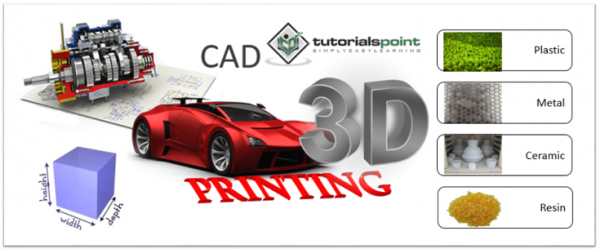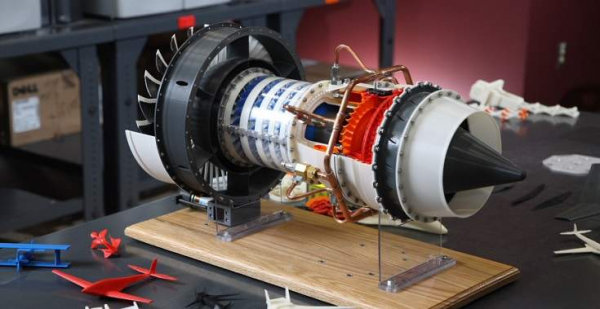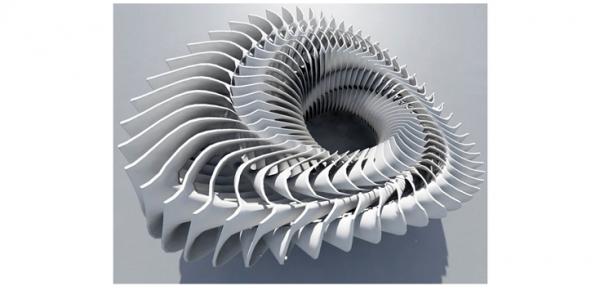
 Data Structure
Data Structure Networking
Networking RDBMS
RDBMS Operating System
Operating System Java
Java MS Excel
MS Excel iOS
iOS HTML
HTML CSS
CSS Android
Android Python
Python C Programming
C Programming C++
C++ C#
C# MongoDB
MongoDB MySQL
MySQL Javascript
Javascript PHP
PHP
- Selected Reading
- UPSC IAS Exams Notes
- Developer's Best Practices
- Questions and Answers
- Effective Resume Writing
- HR Interview Questions
- Computer Glossary
- Who is Who
3D Printing and its future
What is 3D Printing?
3D printing – A future where your printer connected to a desktop is capable of printing a solid object. It’s a process of crafting three dimensional robust objects from a digital file using additive processes. An object is created by positioning consecutive layers of material until the whole object is shaped.
It is also known as rapid prototyping, a mechanized method where 3D objects are quickly made on a reasonably sized machine connected to a computer containing blueprints for the object.

Although the technology has become popular in recent days, it existed well in the 1980s. Charles Hull in 1984 first developed the technology for printing physical 3D objects from digital data. He obtained a patent for the technique “Stereo lithography” in 1986.
The concept of 3D printing is exciting to everyone. According to some futurists, 3D printing is opening up a whole new world which will make life as we know it today barely noticeable in the next few decades. 3D printers in the hands of consumers will mean the end of standardization, and the beginning of products personalized to every individual which helps to create a world where the products we buy have a better fit, a better match to one’s personal style. It’s an amazing explosion of creativity, personal aiding, global connectivity and disruptive innovation in the material world.
Working of 3D printer
First of all, one should have the virtual designs of the object to be created. It is basically done using Computer Aided Design (CAD) software, because the software is built with manufacturing in mind. Once the creation of the digital file is done, the file is prepared for printing by slicing the final model into many cross sectional layers, which are only a fraction of a millimeter thick.The 3D printer reads and blends every slice in such a way that there are hardly any visible sign of the layers.
Another method is using 3D scanners. It can be used to create the digital copy of an object using different technologies to generate a 3D model. These object layers can then be sent to a 3D printer that will print them out, one on top of the other, until they are built up into a complete 3D printed object.
Future of 3D Printing
There is more in the future as this field advances at a staggering rate and futurists are calling it the revolution of 3D printing like never before. Some of the fields where 3D printing application has highest scope in future are −
Developing Complex Engine Parts
Some engines, let’s say Jet engines have quite a few complex designs to manufacture. Fuel Nozzle of jet engines for example, can be developed at a much faster pace using 3D printing with more accuracy and enhanced design. Now that the American designers are working on 3-D printed cars they will find it easier to improvise the design for the advancement in performance.

Dr. David Sheffler’s class built a 3D-printed jet engine replica that was able to spin at 2,000 RPM.
Fashion
3D printing is conquering the fashion world. Although the pioneering new technology still has limitations, more designers are today experimenting with it and creating entirely new looks with more distinguished and more qualitative output.

daniel widrig 3d printed jewelry
Medical applications
One of the most impact-full area of growth will be in the medical field. Where creation of artificial bones and limbs has made way from experimental to practical life and on the other hand there are investigations on the possibility of printing organic materials to replace defective human body parts. There are few cases of successful facial transplants and prosthetic jaw transplant, and 3D printing-based medical techniques have already saved countless lives and opened new doors in medicines which were not imagined before.
Space Explorations
When something goes wrong with the machine parts in space, it is normal procedure to send replacements from earth , which is no easy job and costs millions of dollars. But with a 3D printer in space the required parts can directly printed in space saving up on vital time, cost and reduces potential risks.
Wrapping it up!
Every idea is a revolution when it becomes pragmatically accessible from once being a theoretical dream. Advances in 3D technology has blended the unimaginable into every possible field.
The future of manufacturing is bound to change, with more goods being produced and much closer to point of purchase or consumption. Goods and products will be modified at the consumer’s end because altering them won’t require re-tooling. With end users controlling the manufacturing themselves rather than engaging in trade with other people, it would revolutionize nature of commerce.

